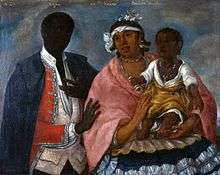Sambo (racial term)
Sambo or Zambo is a derogatory term used for a person with Indigenous American origin and, in some countries, also mixed with African origin. In an 18th-century Mexican casta painting by Ignacio Maria Barreda, zambo is a synonym for lobo (Spanish for "wolf").

Later, its technical meaning was expanded to include people having a mixture of black and white ancestry—mulatto, quadroon, octoroon, etc. in modern US English[1] and British English.[2]
Etymology and usage
The word "sambo" came into the English language from the Latin American Spanish word zambo, the Spanish word in Latin America for a person of mixed African and Native American descent.[3] This in turn may have come from one of three African language sources. Webster's Third International Dictionary holds that it may have come from the Kongo word nzambu ("monkey") — the z of (Latin American) Spanish being pronounced here like the English s. The Royal Spanish Academy gives the origin from a Latin word, possibly the adjective valgus[4] or another modern Spanish term (patizambo), both of which translate to "bow-legged".
The equivalent term in Portuguese-speaking areas, such as Brazil, is cafuzo.
Examples of "Sambo" as a common name can be found as far back as the 19th century. In Thackeray's novel Vanity Fair (serialised from 1847), the black-skinned Indian servant of the Sedley family from Chapter One is called Sambo. Similarly, in Harriet Beecher Stowe's novel, Uncle Tom's Cabin (1852), one of Simon Legree's overseers is named Sambo. Instances of it being used as a stereotypical name for African Americans can be found as early as the Civil War.
Sambo's Grave
Sambo's Grave is the 1736 burial site of a young Indian cabin boy or slave, on unconsecrated ground in a field near the small village of Sunderland Point, near Heysham and Overton, Lancashire, England. Sunderland Point used to be a port, serving cotton, sugar and slave ships from the West Indies and North America.
Little Black Sambo
The name became especially associated with the children's book The Story of Little Black Sambo by Helen Bannerman, published in 1899. It was the story of an Indian boy named "Sambo" who outwitted a group of hungry tigers. Bannerman also wrote Little Black Mingo, Little Black Quasha, and Little White Squibba. In this book, Sambo is the name of a southern Indian boy.
Sambo's restaurant chain
The once-popular Sambo's restaurant chain used the Helen Bannerman images to promote and decorate their restaurants, although the restaurants were originally claimed to have been named after the chain's co-owners, Samuel Battistone and Newell Bohnett,in attempt to mask the racism, the name choice was the contributing factor in the chain's demise in the early 1980s. [5]
References
- "Definition of "Sambo" (US English)". Oxford Dictionaries Online. Retrieved 24 December 2015.
- "Definition of 'Sambo' (British and World English)". Oxford Dictionaries Online. Retrieved 24 December 2015.
- Forbes, Jack. Africans and Native Americans: The Language of Race and the Evolution of Red-Black Peoples. University of Illinois Press, 1993. p. 235.
- Collins Latin Concise Dictionary. Glasgow, Scotland, Great Britain: HarperCollins Publishers, 1997. English-Latin section, p. 20. ISBN 978-0-06-053690-9
- NEWS source SAMBOS in Santa Barbara :https://www.noozhawk.com/article/bizhawk_sambos_santa_barbara_to_change_name_20200604
Bibliography
- Boskin, Joseph (1986) Sambo, New York: Oxford University Press
- Goings, Kenneth (1994) Mammy and Uncle Mose: Black Collectibles and American Stereotyping, Bloomington: Indiana University Press, ISBN 0-253-32592-7
External links
- e-texts of The Story of Little Black Sambo: